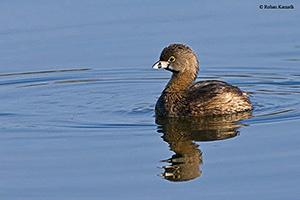 |
Pied-billed Grebe
Podilymbus podiceps |
|
|
STANFORD LOCATIONS: Regular in small numbers at Lagunita, usually in winter but occasionally remaining, possibly to breed, in spring. |
 |
Location |
Type |
Mating System |
Parental Care |
2ndary Diet |
Strategy |
|
|
|
|
I: 23 DAYS PRECOCIAL 4 |
|
|
|
|
(3-10) MONOG? |
MF |
|
| BREEDING: | Usu well-vegetated lakes, ponds, sluggish streams and marshes. 1 brood, 2 in s. |
| DISPLAYS: | Courtship more vocal than visual; male-female duet call. In territorial display at border, males turn away from each other and call, heads held high, bills up, then swing back face to face. |
| NEST: | Inconspicuous, shallow sodden platform of decaying veg anchored in open water among reeds or rushes. Of reeds, grass, often plastered with soft green scum. |
| EGGS: | Bluish-white, chalky, nest-stained buff/brown. 1.7" (43 mm). |
| DIET: | Aquatic insects, also snails, fish, frogs; incidental aquatic veg. Feather balls found in stomach. In winter occ forage in salt water. |
| CONSERVATION: | Winters s to Panama; s populations sedentary. Adaptable, found in developed areas. |
| NOTES: | Most solitary of all N.A. grebes. For proper development, eggs must lose water but this is a problem in hot, wet nest; facilitated by having 3 x more pores for water diffusion, compared with similar eggs of other species. Young carried on back of adult, occ even during dives. Sinks to hide, leaving only head exposed. |
| ESSAYS: | Eating Feathers; Transporting Young; Plume Trade; Swimming; Precocial and Altricial Young. |
| REFERENCES: | Davis et al., 1984; Godfrey, 1986. |
| Help | Abbreviations | Species-Alphabetical | Species-Taxonomic | Essays-Alphabetical | |
| Except for Stanford Locations, the material in this species treatment is taken, with permission, from The Birder's Handbook (Paul Ehrlich, David Dobkin, & Darryl Wheye, Simon & Schuster, NY. 1988). | |||||